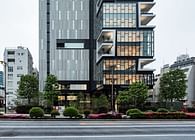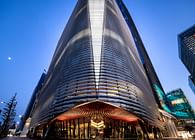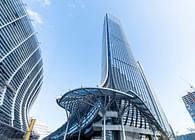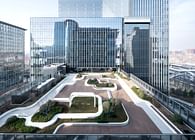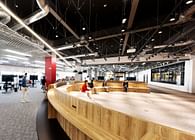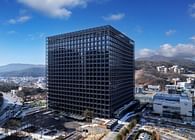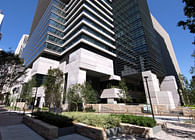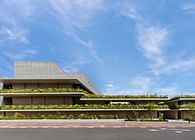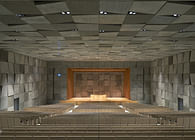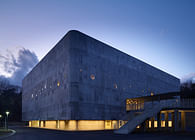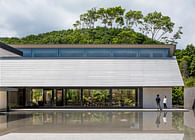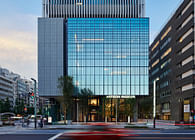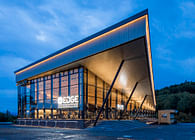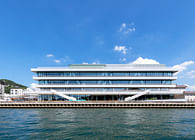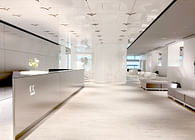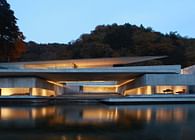
Unique design born from the site’s characteristics
This tenant office building is situated within the MEGURO MARC development district, located halfway between Meguro Station and Gotanda Station along the railway line in a convenient business area in Tokyo. The site is surrounded by residential areas and abundant greenery in a calm environment. The area also features railways to the north, Meguro River’s riverside terrace 10 meters in depth to the south, and proximity to high-rise office buildings and residential buildings.
The building’s distinctive fin-shaped exterior precast concrete (PC) panels serve to avoid direct sightlines with neighboring offices and residences and guide views towards more open directions. These panels also function as sunshades and reduce light pollution, ensuring a high-quality indoor environment while considering the surrounding environment. The diagonal shape of the panels changes the building’s appearance when viewed from different angles, adding an eye-catching effect. The intention was to achieve a monolithic volume above the lush green terrace and a symbolic presence with heavy PC panel walls as seen from the lower part of the riverside terrace. At the main entrance, a large, cantilevered aluminum honeycomb panel canopy with a maximum length of 7.5 meters is installed incorporating a tuned mass damper (TMD) to create a well-defined front-facing appearance.
The deeply carved exterior casts striking shadows, and when combined with the abundant greenery, creates the presence of a new symbol.
Pursuing value as a tenant office
Adopting a cantilevered structure without corner columns achieves a rectangle-shaped leasable area of around 2,000 square meters per floor with comfortable views. To cover a distance of 23 meters between columns, the beam depth is minimized by placing diagonal braces in the equipment shaft, ensuring a column-free space with a ceiling height of 2.8 meters, a floor-to-floor height of 4.25 meters, and a depth of approximately 20 meters.
The tenant-exclusive lounge, located at the southwest corner of the first floor, faces abundant greenery, offering a relaxed atmosphere for various purposes, such as lunch, refreshments, meetings, and events.
Rich spaces created by intriguing materials
The exterior PC panels are finished in an earthy color, suitable for the tranquil surroundings, and the surface is sandblasted to emphasize the material’s texture. In the entrance hall, Oya stone and powder-coated panels are used to take in the exterior’s color tones while creating a sense of tension with the black walls of phosphoric acid-treated panels continuous from the exterior. Furthermore, a “rising garden” is designed using polished landscape stones to represent the water of the Meguro River, a famous waterside spot in the center of the city, rich with greenery. This gives the entrance hall a feeling of the passage of time and changing seasons.
Structural planning for a concentrated vibration control building with displacement amplification mechanism
This is a steel structure plan with a height of approximately 70 meters and 13 floors above ground. The core is placed on the west side of the rectangular floor plan, which measures about 75m x 35m, and a column-free office space is arranged in a U-shape. The structure features a tuned viscous mass damper on the first floor within the core and buckling-restrained braces on the upper floors, aiming to reduce structural damage during major earthquakes and lower response acceleration during earthquakes and strong winds.
The vibration control plan involves using the tuned viscous mass damper to absorb earthquake energy in a concentrated manner and employing buckling-restrained braces on the upper floors to provide rigidity and reduce structural damage by yielding before the main beams during major earthquakes.
The tuned viscous mass damper can amplify displacement and achieve significant energy absorption by bringing the natural frequencies of the building and the damper support structure closer together. In this building, a displacement amplification mechanism utilizing pins is added to the damper support structure to further amplify the input displacement of the damper. As a result, the input displacement of the damper can be amplified to more than twice the inter-story deformation of the building, allowing for efficient and concentrated earthquake energy absorption with fewer damper units.
Environmentally considerate planning
For the lighting plan, energy-efficient and long-lasting LED lighting is adopted throughout the building. In the leasable areas, occupancy and luminosity image sensors are used to control daylight intake and lighting for energy-efficient operations.
As for the thermal environment plan, Low-E double-glazing is used for curtain walls on the typical floors, ensuring high insulation around the windows. The air-conditioning zones are carefully divided so that the interior zones are approximately 50 square meters each and the perimeter zones are divided at every column. This allows for 24-hour flexibility in switching between heating and cooling and adjusting temperature settings.
Business Continuity Plan (BCP)
In the event of a disaster, the emergency generator placed on the rooftop will provide 100% lighting for 72 hours, a power supply of single-phase 10VA/m² and three-phase 15VA/m², and power to continuously use toilets in the office’s leasable areas. Additionally, spaces for accommodating people unable to return home and storage for emergency goods are installed to contribute to the community.
To improve the stability and reliability of power supplies, two separate lines from different systems are drawn from the power company. In case the primary water supply is disrupted, drinking water is preserved in plastic bottles, hand washing water is stored in the water intake tank, and toilet water is reserved in the general service water tank. The collected rainwater on the rooftop is filtered and used for toilet flushing. In the event of a sewer system disruption, the wastewater system can be switched to store sewage in an emergency sewage tank within the building.
Project Details
Project name: JR MEGURO MARC BUILDING
Usage: Tenant Office
Site area (m2): 7,786.48
Total floor area (m2): 38,710.29
Number of floors: 1 basement floor, 13 floors above ground, 2 floors in rooftop structure
Eave height, highest point (m):Eave height 63.38, highest point 69.26
Main structure: Steel (S), partly reinforced concrete (RC), steel-reinforced concrete (SRC)
Completion date: March 2022
Status: Built
Location: Shinagawa Ward, Tokyo
Firm Role: Lead architect
Additional Credits: Owner: JR East Building Co., Ltd
Lead architect: Nikken Sekkei Ltd
Main scope: Nikken Sekkei Ltd (Schematic design, Design development, Site supervision)
JV, Joint design, Supervision, Consultancy, etc.: Miraifukeisha LTD. (Landscape design)
Construction Company: Nishigotanda 3-chome Project Building A New Construction Joint Venture (Joint venture of Takenaka Corporation & Tekken Corporation)





